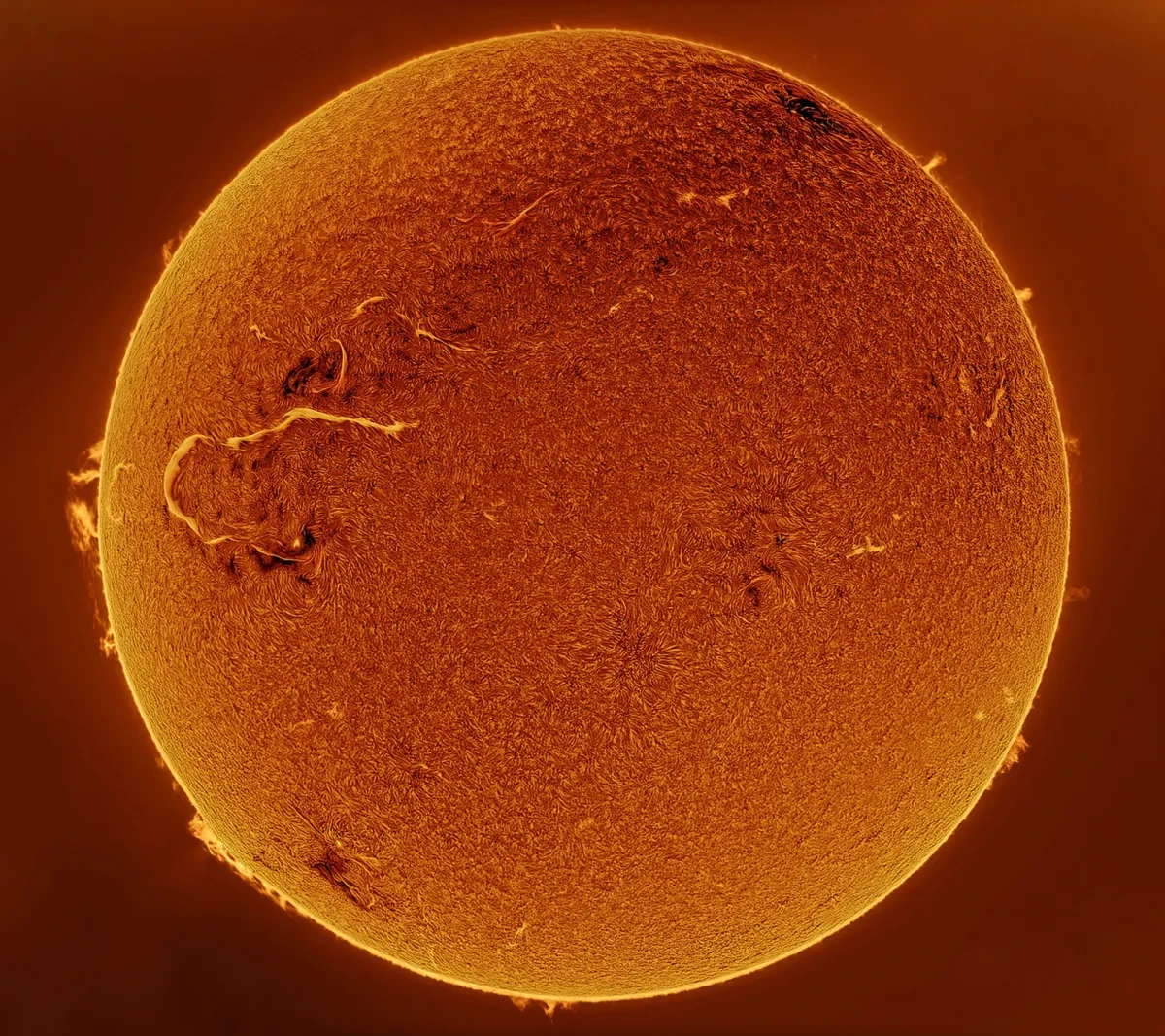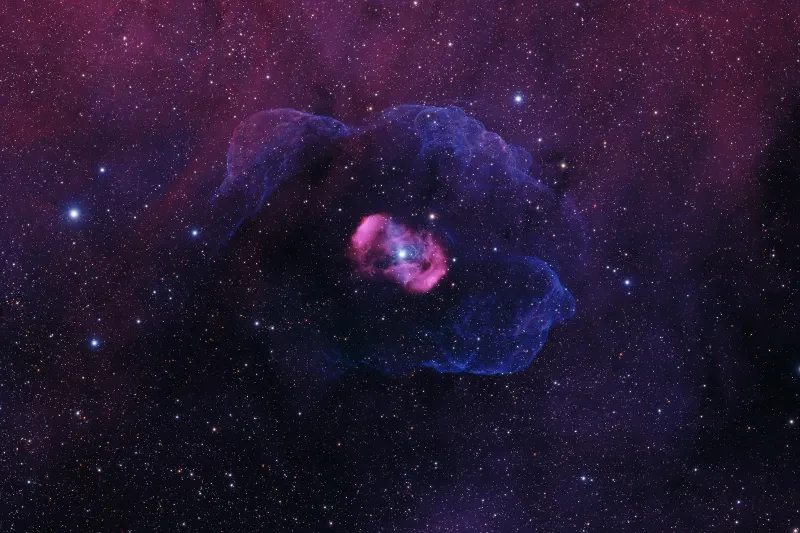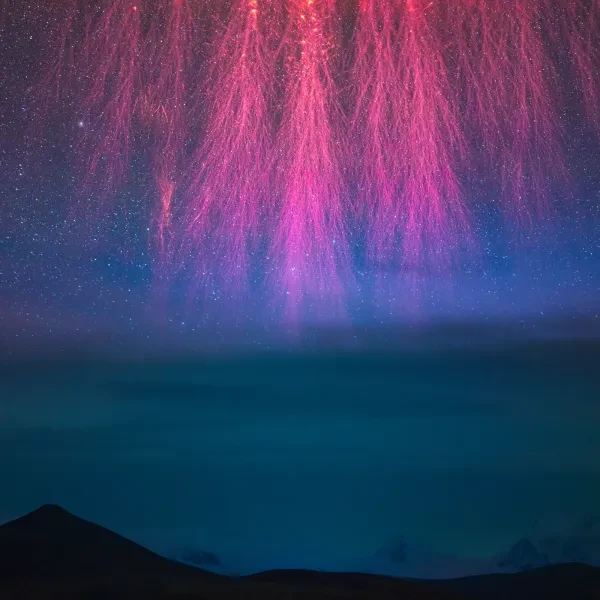The Sun dominates our Solar System in every way and our planet receives much more from it than just light and heat.
Charged particles stream from the Sun’s outer atmosphere, known as the corona, to the edge of the Solar System in a solar wind that travels at around 400–700 kilometres per second. This solar wind carries with it the Sun’s magnetic field. The Earth’s own magnetic field expands and compresses in response to the strength of the solar wind. This interaction can cause problems for Earth-orbiting satellites and electric power grids on the ground, disrupting our communication network.
The entrants to this category have shown great artistic and technical skill to showcase just how dynamic our sun is. Photographs include images that track the Sun’s motion across the sky, display its ever-changing surface and reveal the gigantic plasma structures that extend out to its corona.
See the winners and full shortlist below.

The winning image
A Sun Question by Eduardo Schaberger Poupeau
Taken in Rafaela, Santa Fe, Argentina, 1 October 2022
"The Sun continues to exhibit mysterious behaviour and often its dynamics can be unpredictable," explains winning photographer Eduardo. "On the morning of 1 October, it wanted to show us in a very graphic way that it is a star with many unanswered questions, demonstrated clearly by this huge and beautiful filament in the shape of a question mark.
"This photo is a mosaic of two panels. For each one I captured a video of 1,700 frames and stacked 115 of them with AutoStakkert! and applied wavelets with Registax. The final contrast and colour adjustments were made with Photoshop. This photograph was taken with a planetary camera of only 1.7 megapixels."
Equipment used: Sky-Watcher Evostar 150ED DX Doublet APO refractor telescope at 840 mm focal length 120 mm aperture , Daystar Quark Chromosphere filter, Baader ERF frontal filter, iOptron CEM70G mount, Player One Apollo-M Max camera, Gain 100, 2 panels of 115 x 3.47-millisecond exposures
This is such a clever image as while we have seen the granulation and surface of the Sun before, I've never seen a filament shaped like a question mark before. If you zoom into the surface of the Sun, the image has a paint-like quality – I feel like I can see the brush strokes. There’s a sense of movement and you can almost see the question mark filament moving if you stare long enough.
Sheila Kanani, competition judge

Runner-up
Dark Star by Peter Ward
Taken in Barden Ridge, New South Wales, Australia, 4 January 2023
"When viewed through an extremely narrowband-pass filter centred H-alpha light, our Sun will reveal fleeting magnetic field lines, filaments, flares, spicules and prominences that can change over a matter of minutes," says Peter. "Massive prominences that extend to beyond the radius of the Sun do appear occasionally, but even ‘normal-sized’ events that can appear relatively small compared to the solar disc are vast structures. This image was processed using an inverted polar to rectangular transformation to better showcase the scale and structure of these often-impressive eruptions around the Sun’s periphery. This transformation turns the Sun ‘inside-out’ and in doing so highlights prominence activity around the edge of our nearest star."
Equipment used: Astro-Physics 130GTX telescope, Coronado 90 mm lens, Paramount PMEII mount, QHY533M camera, 1170 mm f/9, best 4% used of 2,000 x 1/20-second exposures (4 seconds total exposure)

Highly commended
The Great Solar Flare by Mehmet Ergün
Taken in Traisen, Germany, 4 September 2022
"Here we see our Sun, photographed using an H-alpha solar telescope," explains Mehmet. "The Sun is moving towards its maximum cycle, and in the photo, we can see a large solar flare. Solar flares are sudden bursts of magnetic energy on the surface of the Sun. These eruptions can be very large, as seen in the image. According to our calculation, this solar flare is about 700,000 km long; Earth has a diameter of about 12,700 km."
Equipment used: LUNT LS60 B1200 Double Stack telescope, Rainbow RST-135 mount, Player One Astronomy Neptune-M 178M camera, 500 mm f/8.3, Gain 13 , 1.5 second exposure
Never miss a shooting star
Sign up to our space newsletter for exclusive astronomy news, guides and events.
See the full shortlist
Explore all the photographs in the Our Sun category.

Falcon Solar Transit by Michael Seeley
Merritt Island Wildlife Refuge, Titusville, Florida, USA, 18 January 2023

The Advance of Darkness by Alessandro Ravagnin
Romano d'Ezzelino, Vicenza, Italy, 25 October 2022

Grazing Mammoths by Rafael Schmall
Zselic Park of Stars, Zselickisfalud, Hungary, 24 September 2022

Sunspots: AR2993 / AR2994 by Tristan Campbell
Harrogate, UK, 21 April 2022

Loop Prominence by Eduardo Schaberger Poupeau
Rafaela, Santa Fe, Argentina, 13 September 2022

Partial Solar Eclipse over Kirti Stambh and Temple, Chittorgarh Fort by Abhinav Singhai
Chittorgarh, Rajasthan, India, 25 October 2022

From Solstice to Solstice by Cem Özkeser and Tunç Tezel
Bursa, Turkey, 21 June to 21 December 2022

Solar Flare X1 from AR2994 in 'Motion' by Miguel Claro
Dark Sky Alqueva region, Évora district, Portugal, 30 April 2022
Our partners



